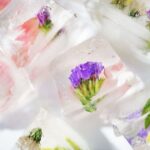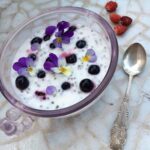Cooking with edible flowers and herbs can be a wonderful new way to add flavor and interest to your favorite recipes, and to branch out to try new recipes.
There are many edible plants with wonderful tastes and visual appeal. Taking the time to research what is edible and which recipes it can be used in will not only add variety to your meals, but also phytonutrients (plant nutrients), vitamins and minerals.
Cooking with Edible Flowers
In terms of herbs, just take a look at any spice rack in a supermarket, and chances are you will see both old favorites, like oregano and basil, with new, intriguing herbs lie borage and cilantro. Most herbs can be grown at home in containers or in the garden. They will be cheaper than store bought, and delightful-tasting when used fresh.
You can also dry your harvested herbs, which will be a lot less expensive than commercial brands. Best of all, your own herbs will be organic and pesticide-free.
Check the following Book: Cooking with Flowers: Sweet and Savory Recipes with Rose Petals, Lilacs, Lavender, and Other Edible Flowers.
Traditional Recipes
Our ancestors wasted nothing. They started as hunter-gatherers, and through a process of elimination, discovered which flowers and herbs could be eaten. This knowledge got passed down through the centuries, and eventually made it into the earliest cookbooks.
Many of these are free online, so you can discover popular dishes from the Middle Ages, or how Shakespeare would have dined.
A World of Recipes
There is also a world of cuisines to explore, each with their own herb combinations. Italian food, Indian, Thai, Chinese… learning about the herbs and spices used can help you add variety to your weekly meals, without expensive restaurants or takeaway.
Soups and Stews
Soups and stews are an excellent way to cook for two reasons. The first is that everything goes into one pot to simmer, for easy cooking and clean-up. The second is that everything is cooked together, so no nutrition is lost.
Soups and stews tend to also be very hearty and filling. They are ideal during chilly weather. Chances are you won?t overeat either, because the food will be so flavorful and satisfying.
The herbs you use will depend on the main ingredients in the soup. For lamb, seasonings like sage, rosemary and thyme will enhance the food. Just add a range of vegetables such as peas and carrots, and some wedges of potato for a complete meal.
Sauces
One of the most popular sauces is Italian tomato sauce to pour over pasta. You can make your own in minutes with some fresh tomatoes that have been cored and quartered, and some oregano, basil and a dash of olive oil. Some people lightly saut? the herbs in the olive oil to release more of the flavor.
Other sauces can liven up chicken, fish and beef. It is all a question of learning which herbs you prefer, which can be a fun journey of exploration.
Garnishes and Decoration

Edible flowers and herbs have also been used for centuries to make food more attractive, in addition to adding flavor if the items used are intended to be eaten.
You can add flowers to ice cubes to add beauty and flavor to a pitcher of drinks, or a platter of cheese.
Your salads can take on new and vibrant colors with the help of nasturtiums and other edible flowers.
Desserts

Edible flowers and some herbs were also the foundation of the desserts our ancestors loved. Rose petals and rose water were highly prized and used in many different recipes.
Violets and other flowers were candied and eaten as is, or used to decorate cakes and puddings. Jellies were also very popular, and were both tasty and nutritious.
